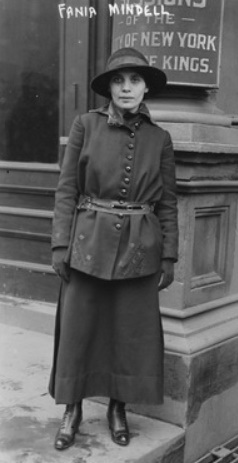The Lilith Blog 1 of 2
August 29, 2017 by Yona Zeldis McDonough
The Unsung Jewish Woman Who Helped Found Planned Parenthood
 The name Margaret Sanger will forever be linked to Planned Parenthood; she was the engine and the driving force behind the organization that was once seen as radical and transgressive—and may in fact seem so again in the very near future since many Republicans are rabid to defund Planned Parenthood using any justification possible. But when I began researching the history of Planned Parenthood for a project of my own, I learned that there are two other lesser known names associated with the founding of this irreplaceable organization: Sanger’s sister, Ethel Higgins Byrne, and an unsung Jewish woman named Fania Mindell.
The name Margaret Sanger will forever be linked to Planned Parenthood; she was the engine and the driving force behind the organization that was once seen as radical and transgressive—and may in fact seem so again in the very near future since many Republicans are rabid to defund Planned Parenthood using any justification possible. But when I began researching the history of Planned Parenthood for a project of my own, I learned that there are two other lesser known names associated with the founding of this irreplaceable organization: Sanger’s sister, Ethel Higgins Byrne, and an unsung Jewish woman named Fania Mindell.
Mindell was born in Minsk, Russia on December 15, 1894. She emigrated to Brooklyn, New York in 1906 with her family. She was an accomplished artist, and became a set and costume designer for Broadway theaters in New York, and her theatrical interests extended to translations of dramatic materials from Russian to English. Her version of Maxim Gorky’s play, “Night Lodging,” was performed at the Plymouth Theater in 1920; Edward G. Robinson was among the performers. A woman of many interests and talents, Mindell was also the proprietor of Little Russia, a small boutique in Greenwich Village, just off Washington Square, which featured curios from Russia, but her true passion was for feminist and progressive causes.
As a young political activist, the 22-year-old Mindell met Sanger and Byrne in 1916, and the three women opened the first birth control clinic in the United States in Brooklyn known as the “Brownsville Clinic” (after the Brownsville section of Brooklyn where it was located). The police monitored the clinic from its opening and sent in a female undercover agent to purchase contraceptive supplies. On October 26, 1916, an undercover police woman and vice-squad officers raided the place, confiscating an assortment of contraceptives from pessaries to condoms, along with 20 “books on young women.” Sanger, Byrne and Mindell were arrested. After being arraigned, Sanger and Mindell spent the night in the vermin-infested Raymond Street jail, and Byrne at the Liberty Avenue station. All were released the next morning on $500.00 bail. They were found guilty and fined for distributing “obscene materials,” but the attention they garnered helped make contraception a national discussion and furthered the cause of women’s rights in America. (The dangers faced by these women connected to Sanger’s pioneering work—many of them Jewish—may be familiar to Lilith readers from “No, Margaret Sanger Wasn’t Jewish”)
Their campaign led to major changes in social policy and to the laws governing birth control and sex education around the world. The Brooklyn clinic closed, but later became the basis for what was to become known as Planned Parenthood.
From there, Mindell’s path diverged from Sanger’s. On December 3, 1929 Mindell married Ralph Edmund LeClercq Roeder, a scholar, historian, and author who shared her interest in theater and leftist causes. The couple traveled extensively in Europe, the Caribbean, and Haiti in the 1930s, but seem to have fallen in love with Mexico by the 1940s. Mindell’s brother, Jacob “Pop” Mindell, a dentist, was a Communist Party member who was later prosecuted and jailed under the Smith Act. Her brother’s views and her association with leftist causes may have influenced the Roeder’s decision to move to Mexico by the 1950s when McCarthyism was prevalent in the United States. Mindell and her husband spent much of their later lives there as expatriates in Mexico City, and that was where, in 1969, they both died, Fania on July 18.
Mindell’s role in the Planned Parenthood story is curiously downplayed. In Ellen Chelser’s Woman of Valor: Margaret Sanger and the Birth Control Movement in America, Mindell rates a brief mention in connection with the opening of the Brownsville Clinic and the arrest—no more. And Miriam Reed’s Margaret Sanger: Her Life in Her Words mentions Mindell not at all.
How did Sanger and Mindell meet? What gave the 22-year-old immigrant who, in 1916, was not yet a United States citizen, the courage and the vision to ally herself with such a cause? Why did she veer away from that cause and what did she do instead? My preliminary search didn’t yield much, but I’m determined to find out. Stay tuned.
The views and opinions expressed in this article are the author’s own and do not necessarily reflect those of Lilith Magazine.
 Please wait...
Please wait...